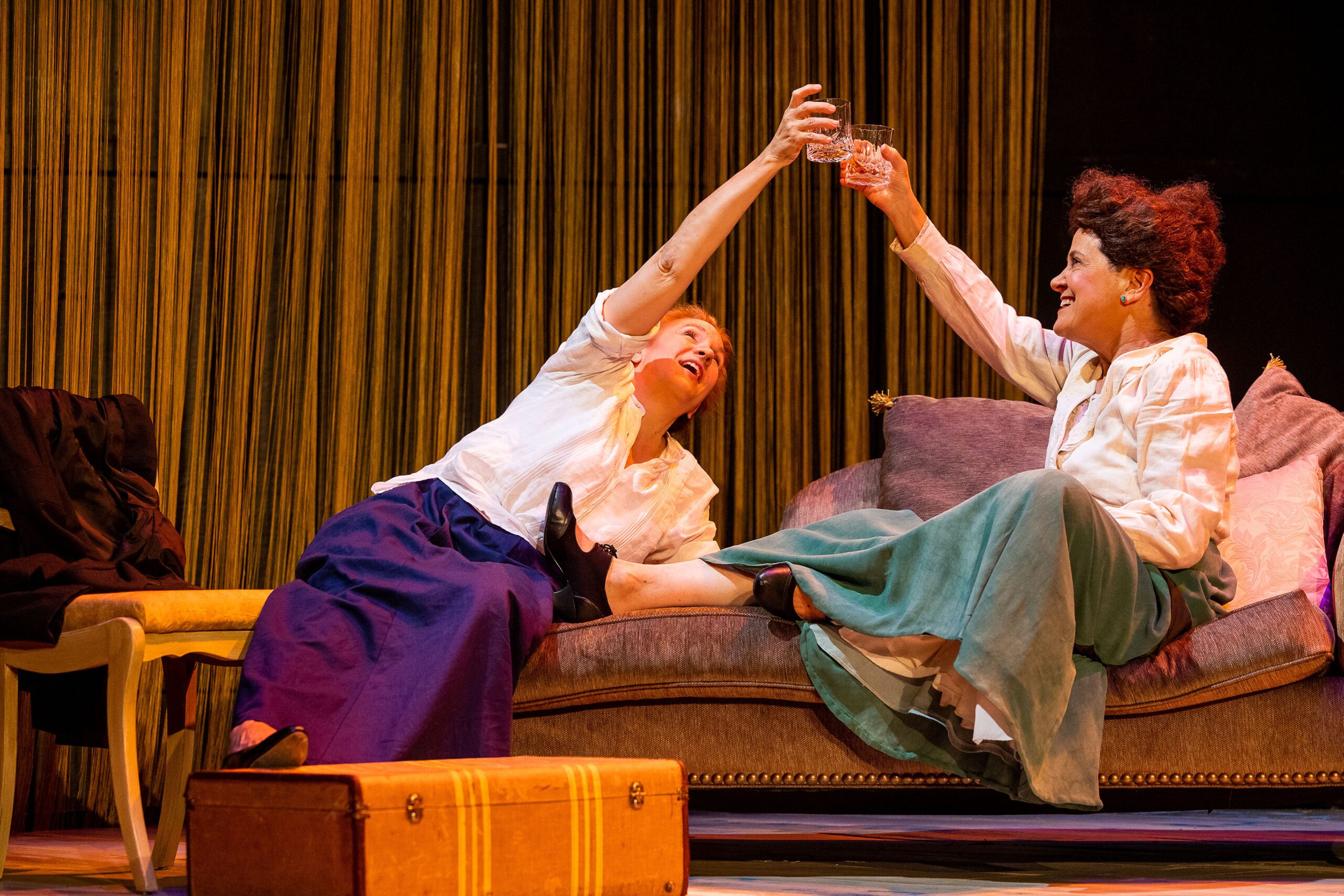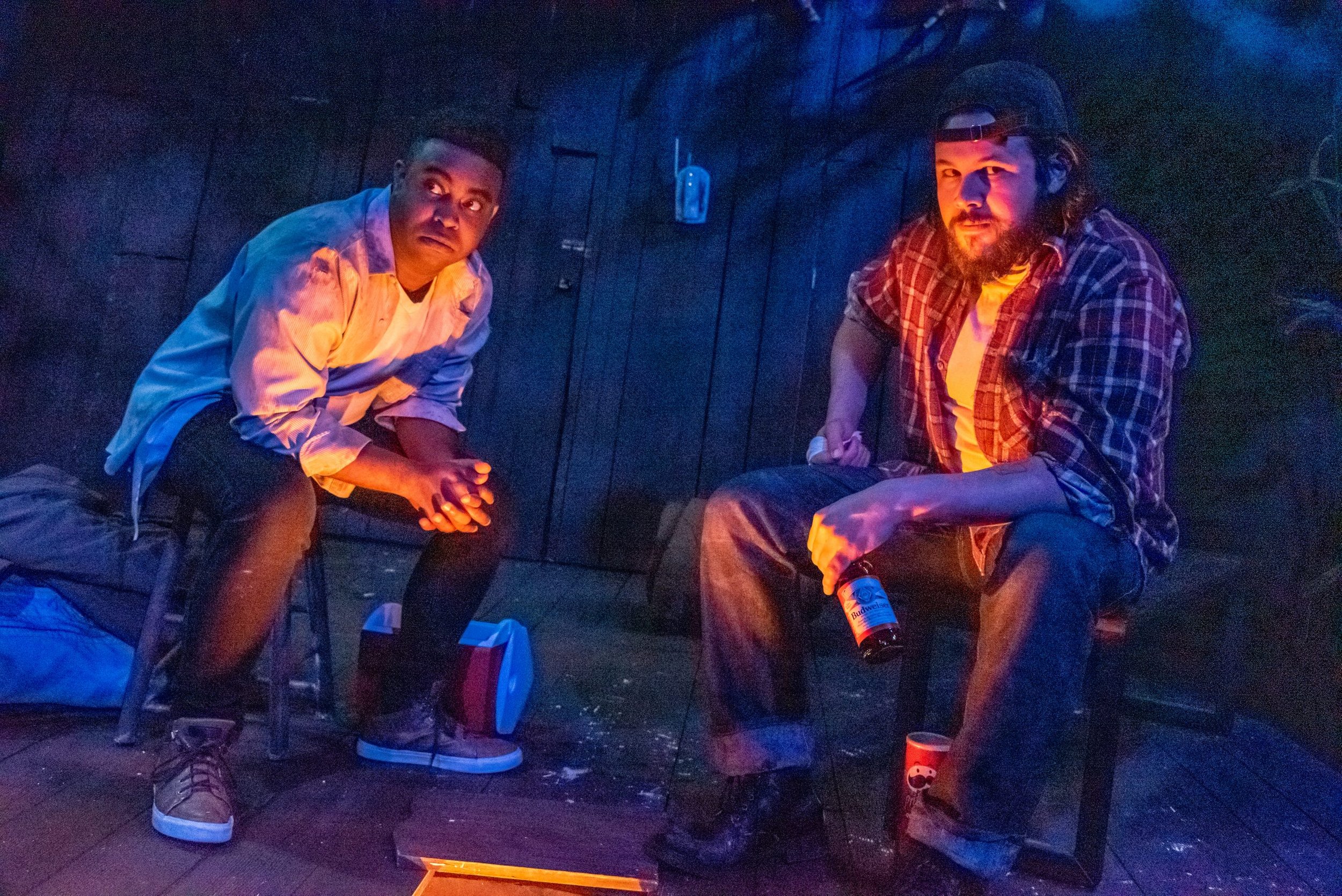The Half-Life of Marie Curie - Central Square Theater
Pictured: Lee Mikeska Gardner and Debra Wise. Photo Credit: Nile Scott Studios
The Half-Life of Marie Curie – The Nora at Central Square Theater
Review by James Wilkinson
The Half-Life of Marie Curie is presented by The Nora at Central Square Theater. Written by Lauren Gunderson. Directed by Bryn Boice. Scenic Designer: Lindsay Genevieve Fuori. Costume Designer: Leslie Held. Lighting Designer: Whitney Brady-Guzman. Props Designer: Jennifer Butler. Sound Designer: Elizabeth Cahill.
I may eat these words by the end of the review but for now I’ll say that it’s hard to get too worked up about Central Square Theatre’s production of The Half-Life of Marie Curie; the play is so unassuming in its intentions. It seems content to keep its head down and do the work that it’s trying to do. So why not let it? Surely no one is going to be irreparably harmed by spending ninety minutes in its company. (I’ve yet to hear a credible story about anyone getting beheaded at the theater.) I’m not convinced that you’re going get anything substantial out of it, but while watching I did eventually reach a mindset of “Go on, take a few whacks at the pinata and see if anything tumbles out.” Is that something? The play by Lauren Gunderson is a loving portrait of the entwining of science and female friendship that’s quite possibly a bit too loving for its own good. It has an agenda, (which isn’t a crime, most plays do), and manages to clamps its teeth down so hard on that agenda that nothing else can get in. The title is a reference to the elemental decay studied by its characters, but in its own ironic way becomes strangely apt to the whole project. We’re only getting half of what we could be out of its subject.
There’s something in the air here that I can’t buy into, however much I may sympathize with the impulses behind the work. Gunderson’s play takes the real-life scientific figures of Marie Curie and Hertha Ayrton (Lee Mikeska Gardner and Debra Wise, respectively) and narrows down its focus to a summer in 1911 when Curie is hit with the one-two punch of winning her second Nobel Prize and having her affair with a married fellow scientist exposed. She should be doing victory laps but the press has turned her into a kind of harlot-of-the-science-lab. Now an outraged mob calling for her head is quite literally pounding on her front door when Ayrton (a notable scientist and engineer in her own right), offers her respite at her seaside home. There, the two scientific minds are brought together to commiserate as women, scientists, wives and mothers.
There isn’t much of a plot so much as there are circumstances, (again, not a crime, but hang on to that for a minute). It feels as though part of Gunderson’s aim was to create a fuller portrait of the women at the heart of her story, to fill in the gaps that arise when all of our knowledge of historical figures comes from biographical sketches in encyclopedias. There’s a loose structure here, aiming for something more reflective. You see it in designer Lindsay Genevieve Fuori’s set which turns Central Square into something of a meditation room. Interlocking circle platforms surrounded by braided curtains isolate the women in pools of their own thoughts. The set up has great potential for a discussion of what it means to be a woman in (what is largely perceived as) a man’s field, in how things have/have not changed in the past century, in what it means for a woman to step into any number of possible roles in her life.
The problem is that Gunderson’s technique doesn’t allow for much of anything approaching subtlety. Subtext becomes text pretty early on when Wise as Ayrton flat out says to Curie, “They wouldn’t treat you this way if you were a man.” I had hoped that would be the only moment the play was so blunt but the comment ends up becoming one of three notes that gets banged on for the rest of the narrative. And to be clear, I don’t doubt that the real-life Curie and Ayrton encountered waves of sexism throughout their lives. That a patriarchal system resisted giving them the respect, resources and accolades they deserved. That however successful they might have been, they could have gone further had their gender not been perceived as a fault. But Half-Life never finds a way to make these truths dramatically interesting beyond stating them outright. The play sticks to the facts and Central Square’s production can’t break out in a way to lets the situations breathe. I find the whole thing claustrophobic. We’re not being asked to confront situations or observe behavior that might have us reflect on our own complicity in patriarchal systems. We’re left to smirk and nod in high-minded smugness each time a character blurts out that a man wouldn’t be treated the way they are. So what are we solving? We’re attending a cheerleading session for our own egos.
And I’d argue that ones most hurt by this approach are Curie and Ayrton. There’s very little for Gardner and Wise to play so the characters lack blood. A good chunk of the piece has Curie a wreck over her dead spouse and married lover. Gardner as Curie curls up into herself, spending much of the first half of the play in distress, face down on a chaise, clutching a pillow. She keeps insisting how important her scientific pursuits are to her but play doesn’t connect them to anything approaching the joy necessary for us to believe her. The closest we get is brief bit about a vial of radium she carries with her, but even that is more about her husband than her own achievements. She’s a wet noodle when she should be alive with the glow of radium. Wise fairs a bit better. She sweeps into the show like Mary Poppins, full of vim and vigor and with just the cure for every ail her friend has. Wise draws herself up, making herself a lighthouse in the storm surrounding her friend. There’s a fire in her and at a certain moment where a poem comes exploding out of Ayrton, you get a sense of what Wise might be able to bring to a character with a few more layers.
As it is, you’re watching two characters agree do nothing but agree with each other. I can appreciate wanting to draw a female friendship where the parties involved support each other rather than undermine. But with everyone so pure of intention all of the time the scenes don’t add up to anything. Interactions appear to only end because it’s been five minutes and we’ve got to change locations to keep the audience’s attention. When a disagreement does appear late in the show, it’s almost as if the play suddenly remembered that it needed a conflict, (don’t worry though, it dissolves half a scene later and for little to no reason). Director Bryn Boice scored a major hit with Speakeasy’s of The Sound Inside earlier this fall. There was some juice in that production because the script gave her some meat to dig into. Here she seems to be struggling to find ways to keep the show visually interesting. At one point the characters resort to walking in circles while they converse because there simply isn’t anything else going on in the scene for us to be looking at.
Does all of this equal a shrug? I suppose. Half-Life paints its portrait but keeps the vivid colors in the box.
The Half-Life of Marie Curie is presented by The Nora at Central Square Theater November 11 to December 12, 2021. For tickets and more information, visit their website: www.dentralsquaretheater.org
Potential patrons should note that proof of COVID Vaccination or a negative COVID test will be required for entry. Masks will be required to be worn during the performance. For more information on this policy, visit their website.
Want to be notified when new reviews/interviews are posted? Consider signing up for our Email List HERE



